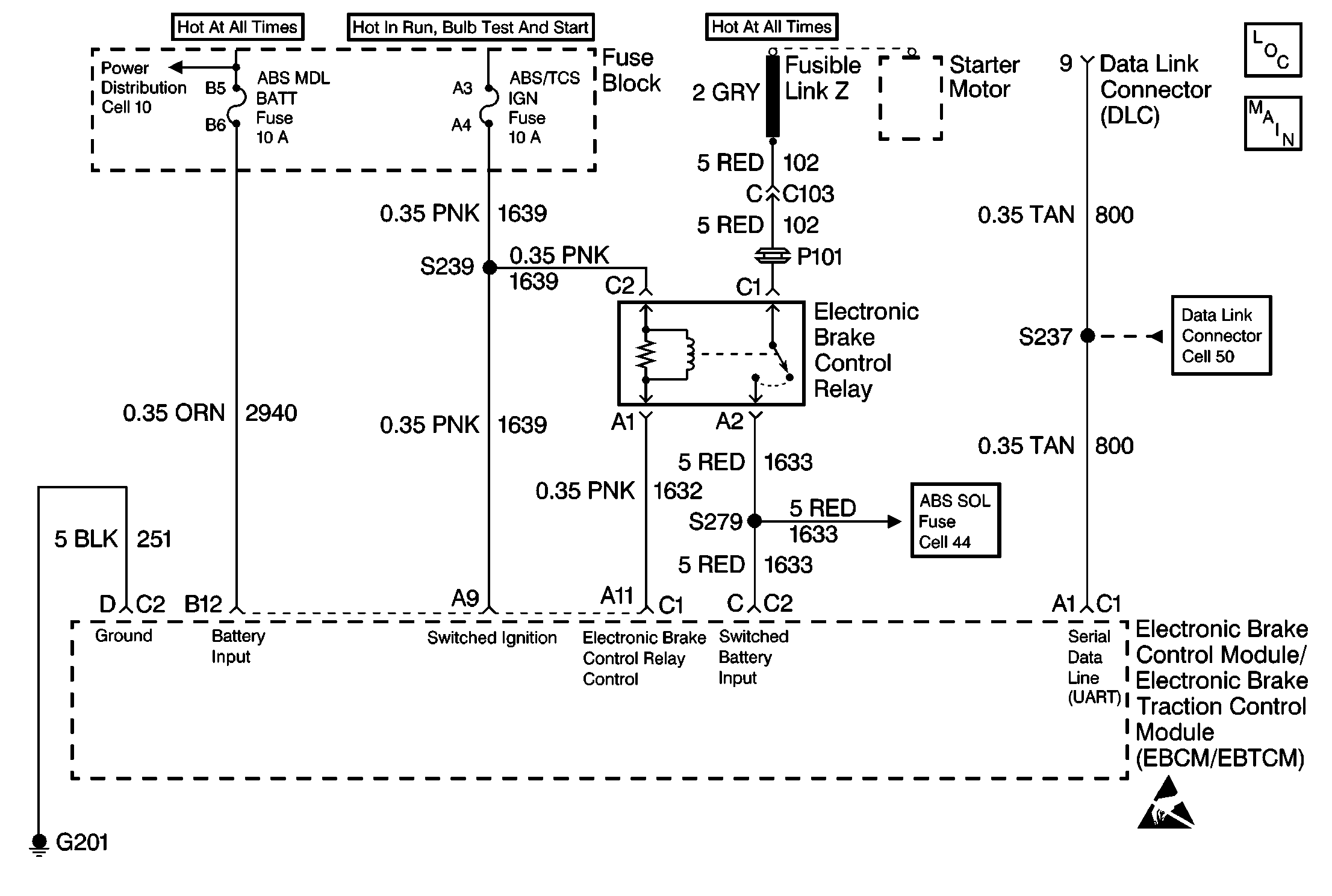
Circuit Description
Ignition voltage is supplied to terminal C2 of the Electronic Brake Control Relay. The above condition enables the EBCM/EBTCM to energize the pullin coil by completing the ground circuit at connector C1 terminal A11 of the EBCM/EBTCM. The magnetic field created closes the Electronic Brake Control Relay contacts. The magnetic field also allows battery voltage and current through the Electronic Brake Control Relay terminal C1 to be supplied to the EBCM/EBTCM through connector C2 terminal C and to the Brake Solenoid Valves through S279.
Conditions for Setting the DTC
DTC C1217 can set before the EBCM/EBTCM commands the Electronic Brake Control Relay on.
DTC C1217 determines if the Electronic Brake Control Relay energizes when the Electronic Brake Control Relay should not energize. The above malfunction would not allow the Electronic Brake Control Relay to remove power to the ABS/TCS system.
If a second malfunction occurs that requires the Electronic Brake Control Relay to turn off the second malfunction cannot be removed if the Electronic Brake Control Relay cannot be controlled.
Action Taken When the DTC Sets
| • | A malfunction DTC stores. |
| • | The ABS/TCS does not disable. |
Conditions for Clearing the DTC
| • | The condition responsible for setting the DTC no longer exists and the Scan Tool Clear DTC function is used. |
| • | 100 drive cycles pass with no DTC detected. |
Diagnostic Aids
The following conditions may cause an intermittent malfunction:
| • | A poor connection |
| • | Rubbed-through wire insulation |
| • | A broken wire inside the insulation |
Use the enhanced diagnostic function of the Scan Tool in order to measure the frequency of the malfunction. Refer to the Scan Tool manual or Scan Tool Diagnostics located in this section for the procedure.
Thoroughly inspect any circuitry that may be causing the intermittent complaint for the following conditions:
| • | Backed out terminals |
| • | Improper mating |
| • | Broken locks |
| • | Improperly formed or damaged terminals |
| • | Poor terminal-to-wiring connections |
| • | Physical damage to the wiring harness |
Clear the DTCs after completing the diagnosis.
Test drive the vehicle for three drive cycles in order to verify that the DTC does not reset.
Use the following procedure in order to complete one drive cycle:
- Start the vehicle.
- Drive the vehicle over 16 km/h (10 mph).
- Stop the vehicle.
- Turn the ignition to the OFF position.
Important: Zero the J 39200 test leads before making any resistance measurements.
Step | Action | Value(s) | Yes | No | ||||||||||
|---|---|---|---|---|---|---|---|---|---|---|---|---|---|---|
1 | Was the Diagnostic System Check performed? | -- | Go to Step 2 | Go to Diagnostic System Check | ||||||||||
2 |
Does the Scan Tool indicate that the electronic brake control relay is off and is the switched battery voltage within the specified voltage? | 0-5V | Go to Step 10 | Go to Step 3 | ||||||||||
3 |
Is continuity present between CKT 1632 and ground? | -- | Go to Step 4 | Go to Step 5 | ||||||||||
4 | Repair the short to ground in CKT 1632. Is the repair complete? | -- | Go to Diagnostic System Check | -- | ||||||||||
5 |
Are there signs of poor terminal contact, corrosion, or damaged terminals? | -- | Go to Step 6 | Go to Step 7 | ||||||||||
6 | Replace all of the terminals or connectors that exhibit signs of poor terminal contact, corrosion, or damaged terminal(s). Is the repair complete? | -- | Go to Diagnostic System Check | -- | ||||||||||
7 |
Is the voltage within the specified range? | 0-2V | Go to Step 11 | Go to Step 8 | ||||||||||
8 |
Does DTC C1217 set as a current DTC? | -- | Go to Step 9 | Go to Step 10 | ||||||||||
9 | Replace the EBCM/EBTCM. Is the repair complete? | -- | Go to Diagnostic System Check | -- | ||||||||||
10 | The system is functioning properly at this time. The malfunction may be intermittent or is not present at the time of testing. Is a concern still present? | -- | Go to Diagnostic Aids | Go to Diagnostic System Check | ||||||||||
11 | Replace the electronic brake control relay. Is the repair complete? | -- | Go to Diagnostic System Check | -- |
